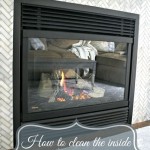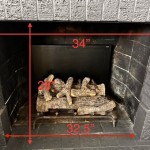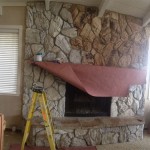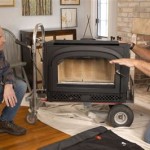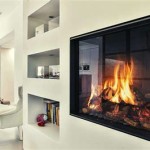Fireplace Damper: Open or Closed? A Comprehensive Guide
The fireplace damper is a critical component of any wood-burning fireplace. Its primary function is to control airflow within the chimney, impacting both the efficiency and safety of the fireplace system. Understanding when to keep the damper open or closed is paramount to operating a fireplace safely and effectively. Incorrect damper operation can lead to significant energy loss, potential safety hazards, and even structural damage to the home. Therefore, a thorough understanding of its purpose and proper usage is essential for any homeowner with a fireplace.
This article presents a detailed examination of the fireplace damper, explaining its operation, the potential problems associated with improper use, and offering specific guidance on determining the appropriate damper position in various scenarios. It will cover the energy efficiency implications, safety considerations related to carbon monoxide risks and fire hazards, and the maintenance aspects that ensure the damper operates correctly. The information presented aims to empower homeowners with the knowledge needed to use their fireplaces responsibly and safely.
Airflow Control and the Damper's Role
The fireplace damper, typically located just above the firebox within the chimney, acts as a gate regulating the flow of air. When open, it allows combustion gases and smoke to escape up the chimney. When closed, it seals the chimney, preventing outside air from entering the home and conditioned air from escaping. This simple mechanism has profound implications for both the efficiency and safety of the fireplace system.
The proper operation of the damper is crucial for creating a draft that effectively pulls smoke up the chimney. The draft is created by the difference in air pressure and temperature between the inside of the chimney and the outside environment. An open damper facilitates this process, allowing the hot gases from the fire to rise, drawing more air into the firebox to sustain combustion. This ensures that smoke is vented safely out of the house and prevents it from entering the living space. A partially open or improperly adjusted damper can disrupt the draft, leading to smoke spillage into the room.
When the fireplace is not in use, the damper should be closed to prevent heat loss during the winter and to keep warm air out during the summer. A chimney is essentially a large vertical shaft that can act as a conduit for air movement. An open damper allows unconditioned outside air to enter the home, increasing heating or cooling costs. Furthermore, it provides an entry point for insects, rodents, and debris. By closing the damper, homeowners can effectively seal off the chimney and minimize these unwanted effects. The effectiveness of the seal can vary depend on the type and condition of the damper, but it generally offers a significant improvement over leaving it open.
Energy Efficiency and Cost Implications
Leaving the fireplace damper open when the fireplace is not in use can significantly impact energy efficiency and increase heating and cooling costs. A chimney, even with the damper closed, is not completely airtight. Air can still leak through small gaps around the damper, but an open damper provides a direct pathway for significant air exchange. During the winter, warm air from the house escapes up the chimney, while cold outside air is drawn in to replace it. This creates a continuous cycle of heat loss, forcing the heating system to work harder to maintain a comfortable temperature. Conversely, during the summer, hot outside air enters the home, increasing the load on the air conditioning system.
The amount of energy lost through an open damper depends on several factors, including the size of the chimney, the temperature difference between the inside and outside of the house, and the airtightness of the damper itself. In some cases, an open damper can account for a substantial percentage of the total heat loss in a home. Studies have shown that the energy lost through an open damper can be equivalent to leaving a window open. This translates to higher energy bills and a larger carbon footprint.
To mitigate these energy losses, homeowners can consider several options. First, ensuring that the damper is properly sealed when closed is essential. If the damper is old or damaged, it may not be sealing effectively. Replacing an old or damaged damper can significantly improve energy efficiency. Another option is to install a top-sealing damper, which is located at the top of the chimney rather than inside the firebox. Top-sealing dampers typically provide a much tighter seal than traditional dampers, further reducing air leakage. Finally, if the fireplace is rarely used, homeowners may consider permanently sealing the chimney. This option involves completely blocking the chimney with insulation and a cap, eliminating any possibility of air leakage. However, this option makes the fireplace unusable.
Safety Considerations: Carbon Monoxide and Fire Hazards
The proper operation of the fireplace damper is not only crucial for energy efficiency but also for safety. An improperly functioning or misused damper can create significant risks, including carbon monoxide poisoning and fire hazards. Carbon monoxide (CO) is a colorless, odorless, and tasteless gas that is produced by the incomplete combustion of fuels such as wood, propane, and natural gas. Exposure to CO can cause serious health problems, including brain damage and death.
When a fireplace is in use, an open damper is essential to ensure that combustion gases, including carbon monoxide, are vented safely up the chimney. A partially closed or fully closed damper can prevent these gases from escaping, causing them to build up in the living space. This can quickly lead to dangerous CO levels, especially in poorly ventilated homes. It is crucial to ensure that the damper is fully open before starting a fire and that it remains open throughout the burning process. Furthermore, it is essential to have a working carbon monoxide detector installed in the home, preferably near sleeping areas, to provide an early warning in case of a CO leak.
In addition to the risk of carbon monoxide poisoning, an improperly functioning damper can also contribute to fire hazards. If the damper is partially closed, it can restrict the airflow, causing the fire to burn hotter and more rapidly. This can increase the risk of sparks and embers escaping from the firebox and igniting nearby combustible materials. Furthermore, a buildup of creosote, a flammable substance formed from wood smoke, can occur in the chimney. A restricted airflow due to a partially closed damper can accelerate creosote buildup, increasing the risk of a chimney fire. Regular chimney cleaning and inspection are essential to prevent creosote buildup and ensure that the chimney is in good working condition. Homeowners should have their chimneys inspected and cleaned annually by a qualified professional.
Homeowners should also be aware of the dangers of starting a fire with the damper closed. This can cause smoke and combustion gases to back up into the living space, creating a fire hazard and potentially leading to smoke damage. It is always best practice to double-check that the damper is fully open before lighting a fire.
Damper Maintenance and Inspection
Regular maintenance and inspection of the fireplace damper are crucial for ensuring its proper function and preventing potential problems. Over time, dampers can become damaged, rusted, or obstructed by debris, affecting their ability to seal properly or operate smoothly. A damaged or malfunctioning damper can compromise energy efficiency, increase the risk of carbon monoxide poisoning, and contribute to fire hazards.
Homeowners should visually inspect the damper at least once a year, preferably before the start of the heating season. The inspection should include checking for signs of rust, corrosion, or physical damage. The damper should move freely and easily between the open and closed positions. If the damper is difficult to operate, it may be due to rust, debris, or a bent mechanism. In such cases, lubricating the damper mechanism with a suitable lubricant can help improve its operation. If the damper is severely damaged or corroded, it may need to be replaced.
In addition to visual inspection, it is also important to check the seal of the damper when it is closed. This can be done by shining a flashlight up the chimney while the damper is closed and observing whether light is visible through any gaps. If light is visible, the damper is not sealing properly and may need to be adjusted or replaced. Another method is to hold a lit incense stick near the closed damper and observe the direction of the smoke. If the smoke is drawn upwards into the chimney, the damper is not sealing effectively.
Regular chimney cleaning is also an important part of damper maintenance. Creosote buildup can obstruct the damper and prevent it from sealing properly. A professional chimney sweep can remove creosote and other debris from the chimney, ensuring that the damper is clean and free to operate. Furthermore, a chimney sweep can inspect the damper and identify any potential problems that may require attention.
Different types of dampers require specific maintenance procedures. Throat dampers, which are located just above the firebox, are the most common type of damper and typically require minimal maintenance. Top-sealing dampers, which are located at the top of the chimney, may require more specialized maintenance, such as adjusting the cable that operates the damper. Homeowners should consult the manufacturer's instructions for specific maintenance recommendations for their type of damper.

How To Open A Chimney Damper Traditional Fireplace Pros

How To Open Your Chimney Damper And Tell If It S Or Closed Priddy Solutions

Basic Home Improvements How Do You Open A Fireplace Damper

How To Open Fireplace Damper The Blog At Fireplacemall

How To Use A Fireplace Damper The Right Way

How To Open A Chimney Damper Traditional Fireplace Pros

What S The Purpose Of A Chimney Damper Where Is It Located

Fireplace Damper Repair Full Service Chimney Kansas City

How To Open A Damper 3 Types Rotary Double Pivot

Your Damper Is Important All Year Long Best Cincinnati Chimney
Related Posts



